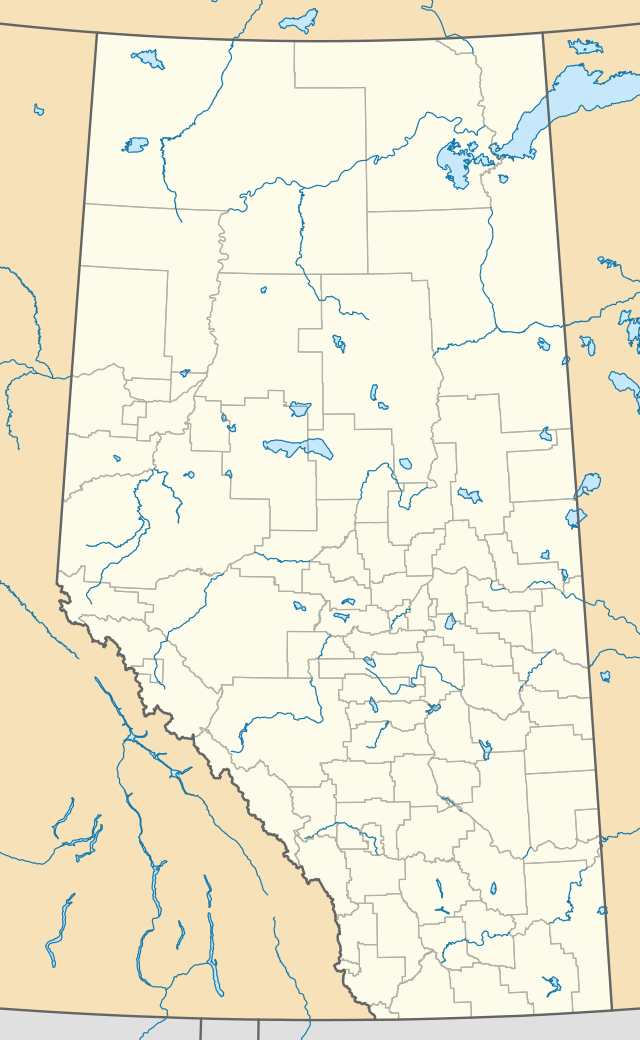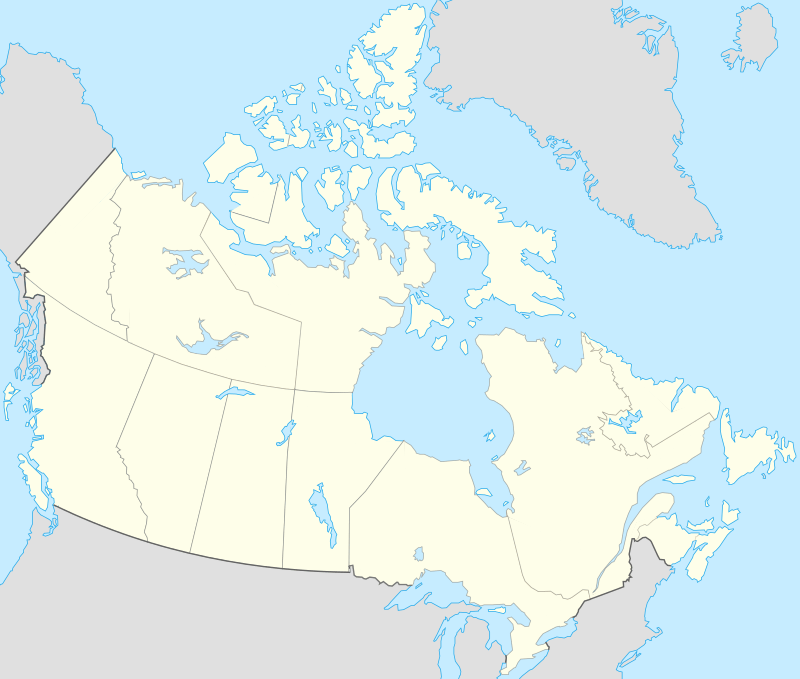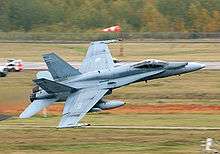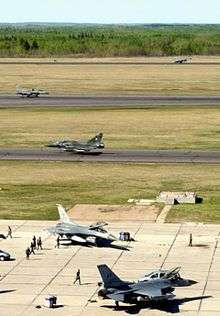CFB Cold Lake
Canadian Forces Base Cold Lake (IATA: YOD, ICAO: CYOD), commonly abbreviated CFB Cold Lake, is a Canadian Forces Base located 5.5 nautical miles (10.2 km; 6.3 mi) southwest[1] of Cold Lake, Alberta. It is operated as an air force base by the Royal Canadian Air Force (RCAF) and is one of two bases in the country housing the CF-18 Hornet fighter, the other being CFB Bagotville. Its primary RCAF lodger unit is 4 Wing, commonly referred to as 4 Wing Cold Lake.
CFB Cold Lake Cold Lake/Group Captain R.W. McNair Airport | |||||||||||||||||||
|---|---|---|---|---|---|---|---|---|---|---|---|---|---|---|---|---|---|---|---|
.jpg) | |||||||||||||||||||
| Summary | |||||||||||||||||||
| Airport type | Military | ||||||||||||||||||
| Owner | Government of Canada | ||||||||||||||||||
| Operator | DND | ||||||||||||||||||
| Location | Cold Lake, Alberta | ||||||||||||||||||
| Built | 1952 | ||||||||||||||||||
| Time zone | MST (UTC−07:00) | ||||||||||||||||||
| • Summer (DST) | MDT (UTC−06:00) | ||||||||||||||||||
| Elevation AMSL | 1,775 ft / 541 m | ||||||||||||||||||
| Coordinates | 54°24′18″N 110°16′46″W | ||||||||||||||||||
| Map | |||||||||||||||||||
 CYOD Location in Alberta  CYOD CYOD (Canada) | |||||||||||||||||||
| Runways | |||||||||||||||||||
| |||||||||||||||||||
Civilian passenger service was available through the Medley passenger terminal on the periphery of the air base. The regularly scheduled air service between Calgary and the civilian terminal was cancelled in June 2011.[3] Unscheduled civilian air traffic is usually directed to Cold Lake Regional Airport.
The facility is named Cold Lake/Group Captain R.W. McNair Airport. It is one of only three military aerodromes in Canada to be named after an individual, Valcartier (W/C J.H.L. (Joe) Lecomte) Heliport and Moose Jaw/Air Vice Marshal C.M. McEwen Airport being the others.
The airport is classified as an airport of entry by Nav Canada and is staffed by the Canada Border Services Agency; however its use by international flights is currently restricted to military aircraft and personnel.[1]
History
Construction of what would become known as RCAF Station Cold Lake began in 1952 at the height of the Cold War after the site in Alberta's "Lakeland District" was chosen by the RCAF for the country's premier air weapons training base. The chosen location was near the former Town of Grand Centre (now part of the City of Cold Lake), and was based on factors such as low population density, accessibility, weather, suitable terrain, and available land for air weapons training. Although the location of the range attempted to avoid First Nations reserves, it "encompassed traditional Aboriginal and treaty areas and the First Nations affected by the creation of the Cold Lake Air Weapons Range (CLAWR) were eventually compensated."[4]
Personnel arrived at Cold Lake on March 31, 1954, with operations at RCAF Station Cold Lake beginning that day. The following year, the federal government signed an agreement with the provinces of Saskatchewan and Alberta for use of a tract of land measuring 180 km by 65 km covering an area of 11,700 square kilometres. This became known as the Cold Lake Air Weapons Range (CLAWR) and is the raison d'être for the location of the base.
CLAWR is the northern equivalent to the United States Air Force's (USAF) Nellis Air Force Range and provides a different training environment with heavy boreal forest and numerous lakes more closely resembling European terrain. It hosts over 640 actual targets and 100 realistic target complexes, including 7 simulated aerodromes with runways, tarmac, aircraft, dispersal areas and buildings, as well as mechanized military equipment such as tanks, simulated radar and missile launching sites, mock industrial sites, and command and control centres.

Operations in the 1950s and early 1960s centered around training crews destined for the CF-100 Canuck all weather interceptor which was in operational use in Canada and Western Europe. From 1962 onwards, the arrival of the CF-104 Starfighter resulted in a change of task, to the training pilots for Canada's NATO commitment in West Germany, which continued up until the arrival of the CF-18 Hornet in 1982. From then through the present, the base is the training focal point for this aircraft, in addition to operational squadrons being located here.
On February 1, 1968, the RCAF was merged with the Royal Canadian Navy and Canadian Army to form the unified Canadian Forces. RCAF Station Cold Lake saw its name changed to CFB Cold Lake and became the responsibility of Air Defence Command. ADC and several other CF commands transformed in 1975 to become Air Command (AIRCOM).

During the 1980s, CFB Cold Lake was thrust into the international media spotlight when CLAWR was used as the target for testing of the newly developed AGM-86 Tomahawk air-launched cruise missiles by the USAF. These missiles were launched from strategic bombers over the Beaufort Sea and traveled down the Mackenzie River valley, closely following the terrain at elevations of several metres above ground level. The tests caused significant controversy among peace activists and local First Nations on the projected flight paths since the new untested weapons were considered a destabilizing force in the international arms race, potentially contributing to instability worldwide. The Federal Court of Canada ruled in favour of allowing the tests to proceed in 1983 and the Canada–United States Test and Evaluation Program or CANUSTEP agreement was subsequently signed between both nations, allowing for the cruise missile tests to use Canadian airspace in the Northwest Territories and Alberta en route to CLAWR.
In 1990, 18 sounding rockets were launched.[5]
In 2000/2001, several CFB Cold Lake - 4 Wing buildings were recognized as Federal Heritage buildings on the Register of the Government of Canada Heritage Buildings: Hangars 1, 2, 3, 4, 6 and the Senior NCO's Building B-30.[6]
In 2007, this was the setting for Jetstream, a TV series depicting eight pilots training under the 410 Tactical Fighter Training Squadron to fly a CF-18.
Current use

Today, CFB Cold Lake has the following units stationed at the facility:
- 401 Tactical Fighter Squadron (CF-18 Hornet)
- 409 Tactical Fighter Squadron (CF-18 Hornet)
- 410 Tactical Fighter Operational Training Squadron (CF-18 Hornet)
- 417 Combat Support Squadron (CH-146 Griffon)
- 419 Tactical Fighter Training Squadron (CT-155 Hawk)
- 1 Air Maintenance Squadron
- 42 Radar Squadron
- 10 Field Technical Training Squadron
It also hosts a number of Lodger Units, including the Aerospace Engineering Testing Establishment, 4 Construction Engineering Squadron, 1 Military Police Squadron, Real Property Operations Detachment Cold Lake, and 22 Health Services Centre.
In addition to its use as a training base, CFB Cold Lake's fighter/interceptor aircraft defend the western half of Canadian air space and together with aircraft from CFB Bagotville cover Canada's Arctic territory. They are operationally controlled by NORAD from CFB North Bay and Cheyenne Mountain Operations Centre in Colorado Springs. Cold Lake aircraft forward deploy to airfields throughout western and Arctic Canada as operational requirements dictate.
Cold Lake also hosts NATO flight training operating from 15 Wing Moose Jaw, as well as 5 Wing Goose Bay. MAPLE FLAG is a major international air weapons training competition hosted annually by CFB Cold Lake in May–June, making use of CLAWR. The name is derived from the USAF's famous Red Flag training exercises at the Nellis Air Force Range in Nevada. NASA and ESA astronauts use Cold Lake for winter survival training.[7]
Cadet Training Centre
Cold Lake Cadet Training Centre (CLCTC) is located at 4 Wing Cold Lake, held annually from June through August. The primary goal at CLCTC is the provision of a safe and challenging national summer training program. The Senior Leaders Course (SLC) moved to CFB Cold Lake in 1973.[8] From 1973 to 1987, SLC was the only course offered at Cold Lake until the Survival School (which hosts two courses: Survival Instructor and Basic Survival) relocated there in 1988. At that time the two schools existed separately with two separate commanding officers. By 1989, the two united under one commanding officer and became Cold Lake Cadet Camp (CLCC).[8] In 1993, the camp added a third school, the Cadet Service Band, which ran for one year as both a Band and SLC but has now become solely a band program. These three schools make up CLCTC.[8] The entire Cold Lake Cadet Training Centre has a staff of approximately 205 staff cadets, officers, civilian instructors, regular force, and civilian contract personnel, from all elements of the Cadet Program and from all regions of Canada.[8] The summer 2010 introduced an entirely new school to CLCTC: The Fitness School which also implemented the first Basic Fitness and Sports Course to CLCTC. The Basic Fitness and Sports is a three-week course that encourages physical fitness and teaches cadets to be fitness and sports advisors in their home squadrons/units/corps. After the summer of 2010, the single, national, Senior Leaders Course was discontinued in favour of the Leadership and Ceremonial Instructors Course to be offered in each region. The summer of 2011 introduced a new six week seniors course to the Fitness School; Fitness and Sports Instructor Course (FSIC). The new FSIC teaches cadets to be Fitness and Sports Instructors within their home squadrons/units/corps.
4 Wing Brass and Reed Band
CFB Cold Lake sports a unit band that serves under the auspices of the 4 Wing of the RCAF. The band in its modern form was established in November 1982 after a resolution by the National Defence Headquarters in Ottawa.[9] It performs public duties for the base as well as the city of Cold Lake and what was formerly Lakeland County.[10]
The following have served as bandmasters for the band:
- Jeff Gaye (1990–2009)
- Cam Martin (2014–2015)
- Jeremy Duggleby (since 2015)
Non-military use of the CLAWR
Non-military use of the CLAWR increased since the 1990s, and "will continue to grow as various sectors vie for access to airspace, land and resources (such as natural gas, commercial fishing, and logging) in and around the range.[4] Canadian Natural Resources Limited's (CNRL) Primrose and Wolf Lake in situ oil sands project near Cold Lake (operated by CNRL subsidiary Horizon Oil Sands use the high pressure cyclic steamstimulation (HPCSS).[11]
References
- Canada Flight Supplement. Effective 0901Z 16 July 2020 to 0901Z 10 September 2020.
- Synoptic/Metstat Station Information Archived December 1, 2011, at the Wayback Machine
- "Northwestern Air News". Archived from the original on 2011-08-27. Retrieved 2011-09-24.
- P. Whitney Lackenbauer (2004). "Cold Lake (Primrose Lake) Air Weapons Range, 4 Wing". Encyclopedia of Saskatchewan. Archived from the original on 2013-05-27. Retrieved 2013-07-30.
- www.astronautix.com
- http://www.pc.gc.ca/apps/beefp-fhbro/FHB_Rech_Search_e.asp%5B%5D Register of the Government of Canada Heritage Buildings.
- The Real Survivors
- "About Cold Lake". Royal Canadian Air Cadets. Retrieved 26 March 2009.
- http://couriernews.ca/2017/10/03/concert-will-celebrate-35-years-of-the-4-wing-band/
- http://couriernews.ca/2017/09/05/4-wing-welcomes-the-newly-posted-members/
- "Alberta Energy Regulator orders enhanced monitoring and further steaming restrictions at Primrose and Wolf Lake projects due to bitumen emulsion releases". AER. 18 July 2013. Archived from the original on 2013-07-30. Retrieved 2013-07-30.
External links
| Wikimedia Commons has media related to CFB Cold Lake. |
- Official Webpage
- Page about this airport and CF base on COPA's Places to Fly airport directory
- Exercise MAPLE FLAG
- Official website for Jetstream, a television show shot at CFB Cold Lake
- Past three hours METARs, SPECI and current TAFs for Cold Lake Airport from Nav Canada as available.